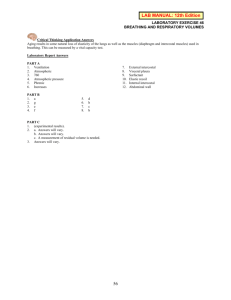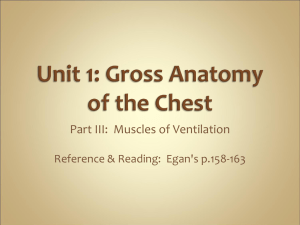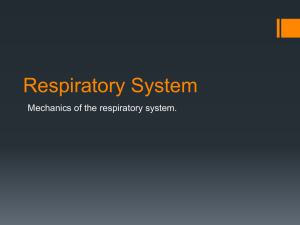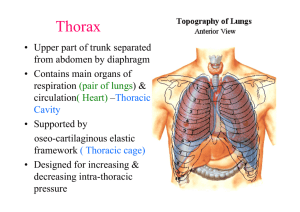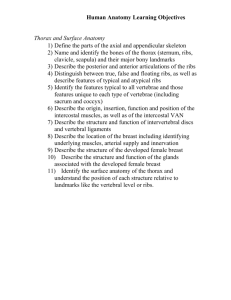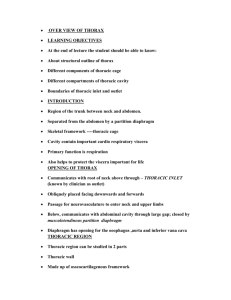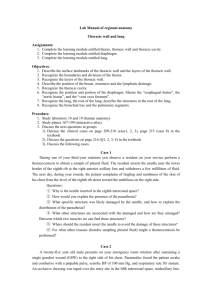6. Muscles of the Thoracic Wall - Yeditepe University Pharma Anatomy
advertisement
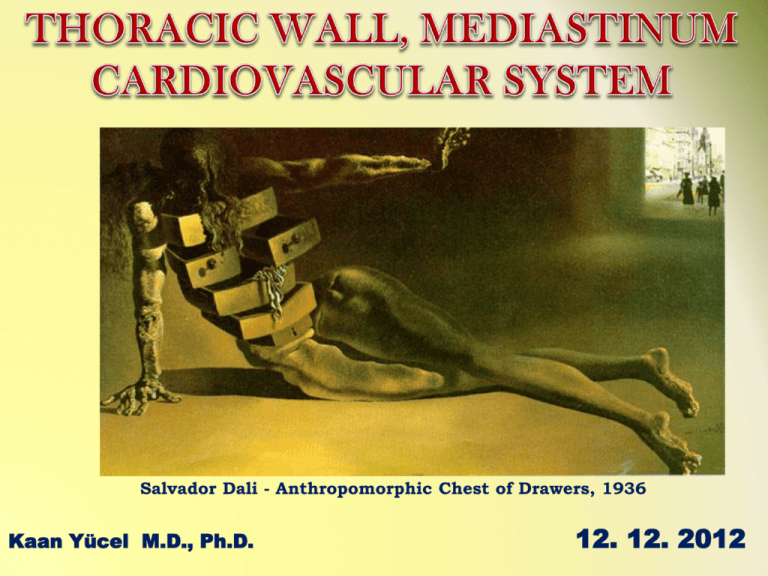
Salvador Dali - Anthropomorphic Chest of Drawers, 1936 Kaan Yücel M.D., Ph.D. 12. 12. 2012 the part between the neck and the abdomen Chest X-ray 1.1. REGIONS/T ERMS Thoracic cavity cavity between neck and abdomen protected by the thoracic wall. Thoracic wall bounds the thoracic cavity. formed by the skin, bones, fasciae, and muscles. Thoracic cage bony portion of the thoracic wall thoracic skeleton 1.2. SURFACES OF THE THORAX STERNUM & COSTAL CARTILAGES anteriorly 12 THORACIC VERTEBRAE & POST. RIBS posteriorly RIBS & INTERCOSTAL SPACES laterally Posterior surface 12 thoracic vertebræ & posterior parts of the ribs Anterior surface sternum & costal cartilages Lateral surfaces ribs, separated by the intercostal spaces 1.3. BOUNDARIES OF THE THORAX Superior • • • • • Jugular notch Sternoclavicular joint Superior border of clavicle Acromion Spinous processes of C7 Inferior • • • • Xiphoid process Costal arch 12th and 11th ribs Vertebra T12 1.4. CONTENTS OF THE THORAX Organs of the cardiovascular, respiratory, digestive, reproductive, immune, and nervous systems • • • • • thoracic cage (skeleton) muscles between the ribs skin subcutaneous tissue muscles, and fascia covering its anterolateral aspect. The mammary glands of the breasts lie within the subcutaneous tissue of the thoracic wall. 2.1. FUNCTIONS OF THE THORACIC WALL 1) Protects vital thoracic and abdominal organs 2) Resists the negative (sub-atmospheric) internal pressures generated by the elastic recoil of the lungs and inspiratory movements. 3) Provides attachment for and support the weight of the upper limbs. 4) Provides the origins of many of the muscles that move and maintain the position of the upper limbs relative to the trunk. 5) Provides attachments for muscles of the abdomen, neck, back, and respiration. 3. SKELETON OF THE THORACIC WALL 1) 12 pairs of ribs and associated costal cartilages 2) 12 thoracic vertebrae and the intervertebral (IV) discs interposed between them 3) Sternum 4. THORACIC APERTURES ‘Thoracic inlet’ ‘Thoracic outlet’ 4.1. Superior thoracic aperture “doorway” between the thoracic cavity and the neck and upper limb bounded: Posteriorly vertebra T1 Laterally 1st pair of ribs and their costal cartilages Anteriorly superior border of the manubrium Trachea Esophagus nerves, and vessels that supply and drain the head, neck, and upper limbs. 4.2. Inferior thoracic aperture By closing the inferior thoracic aperture, the diaphragm separates the thoracic and abdominal cavities almost completely. bounded: Posteriorly 12th thoracic vertebra Posterolaterally 11th and 12th pairs of ribs Anterolaterally joined costal cartilages of ribs 7-10 costal margins Anteriorly xiphisternal joint 5. JOINTS OF THE THORACIC WALL 1. Costotransverse joints between tubercle of a rib & transverse process of its own vertebra 2. Sternocostal joint between the sternum and costal cartilages 3. Costachondralis joint between the rib and costal cartilage 4. Intercondral joints Synovial joints between the costal cartilages of 6th and 7th, 7th and 8th, & 8th and 9th ribs. 5. Sternal Joints between the manubrium, body, xiphoid process of the sternum. 6. MUSCLES OF THE THORACIC WALL Serratus posterior Levator costarum Intercostal muscles(External, internal and innermost) Subcostal Transverse thoracic 6. MUSCLES OF THE THORACIC WALL intercostal muscles three flat muscles found in each intercostal space external intercostal muscles most superficial internal intercostal muscles between external & innermost muscles 6. MUSCLES OF THE THORACIC WALL external intercostal muscles extend from the inferior margins of the ribs above to the superior margins of the ribs below pass obliquely anteroinferiorly 6. MUSCLES OF THE THORACIC WALL internal intercostal muscles most active during expiration between most inferior lateral edge of costal grooves of the ribs above, to the superior margins of ribs below in the opposite direction to those of the external intercostal muscles obliquely posteroinferiorly Attachment to interosseus parts move down during expiration! 6. MUSCLES OF THE THORACIC WALL innermost intercostal muscles least distinct of the intercostal muscles same orientation as the internal intercostals neurovascular bundles (V.A.N.) in the costal grooves in a plane between innermost & internal intercostal muscles. 6. MUSCLES OF THE THORACIC WALL transversus thoracis muscles on the deep surface of the anterior thoracic wall & @ same plane as innermost intercostals lie deep to the internal thoracic vessels secure these vessels to the wall. 6. MUSCLES OF THE THORACIC WALL subcostales @ same plane as innermost intercostals Fibers parallel the course of the internal intercostal muscles. Extend from the angle of the ribs to more medial positions on the ribs below. 6.1. Accessory muscles of respiration upper accessory muscles assist with inspiration. upper chest, and abdominal muscles assist with expiration. 6.1. Accessory muscles of respiration Scalene muscles elevate, fix & expanding the upper chest during inspiration. Sternocleidomasteoid muscles raise the sternum expand the chest’s A-P & longitudinal dimensions. 6.1. Accessory muscles of respiration Axioappendicular muscles act primarily on the upper limbs. pectoralis major Attachment to first seven costal cartilages pectoralis minor Attachment to anterior surfaces of the 3rd-5th ribs inferior part of the serratus anteriorAttachment to lateral surfaces of upper 8-9 ribs & deep fascia overlying related intercostal spaces help elevate the ribs to expand the thoracic cavity. 6.1. Accessory muscles of respiration Trapezius raises the thoracic cage. Attachment to spinous processes of the thoracal vertebrae 6.1. Accessory muscles of respiration Expiration Abdominal muscles pull the lower chest down depress the lower limbs compress the abdominal content & exerts pressure on chest. 7. MOVEMENTS OF THE THORACIC WALL One of the principal functions of the thoracic wall and the diaphragm is to alter the volume of the thorax and thereby move air in and out of the lungs. During breathing, the dimensions of the thorax change in vertical, lateral, and A-P directions. Diaphragm contracts Depression Diaphragm relaxes Elevation (during passive expiration) Elevation &depression of the ribs inspiration Diaphragm conracts; thoracic cavity descends, compressing the abdominal viscera expiration (back to neutral position) Lungs produces sub-atmospheric pressure As a result, the diaphragm ascends, diminishing the vertical dimension. intercostal muscles contract pump-handle movement Movement of the ribs (primarily 2nd-6th) at the costovertebral joints causes the anterior ends of the ribs to rise + Slight elevation in A-P of the sternum . intercostal muscles contract, raising the middle (lateralmost parts) of the ribs (especially the lower ones) bucket-handle movement 9. VASCULATURE OF THE THORACIC WALL Mainly posterior and anterior intercostal arteries pass between adjacent ribs in intercostal spaces. 9.1. ARTERIES OF THE THORACIC WALL Arterial supply to the thoracic wall derives from Thoracic aorta [posterior intercostal & subcostal arteries] Subclavian artery [internal thoracic & supreme intercostal arteries] Axillary artery [superior & lateral thoracic arteries] intercostal arteries course through the thoracic wall between the ribs. Each intercostal space is supplied by • a large posterior intercostal artery • small pair of anterior intercostal arteries Exception last two intercostal spaces Anterior intercostal arteries (paired) directly or indirectly from internal thoracic artery 1st-6th (from internal thoracic artery) 7th-9th (from musculophrenicbranch of internal thoracic) Posterior intercostal arteries (large, unpaired) 1st-2nd (from supreme intercostal artery- branch of costocervical trunk) 3rd-11th (from thoracic aorta) Subcostal artery (from thoracic aorta) internal thoracic artery •Very first branch of the subclavian artery •Passes vertically through the superior thoracic aperture •Lies posterior to the costal cartilages of the upper 6 ribs •Lies 1 cm lateral to the sternum. @ level of 6th intercostal space, divides into 2 terminal branches superior epigastric artery & musculophrenic artery 9.2. VEINS OF THE THORACIC WALL Most posterior intercostal veins (4-11) end @ azygos/hemiazygos venous system conveys venous blood to SVC. 1st posterior intercostal veins right & left brachiocephalic veins 2nd & 3rd (sometimes 4th) form superior intercostal vein. Right superior intercostal vein final tributary of azygos vein Left superior intercostal vein empties into left brachiocephalic vein. Veins Artery Nerve V.A.N. 10. NERVES OF THE THORACIC WALL 12 pairs of intercostal nerves anterior rami of spinal nerves T1 to T11 lie in the intercostal spaces between adjacent ribs. Anterior ramus of spinal nerve T12 (subcostal nerve) inferior to rib XII. • Near the angles of the ribs, the nerves pass between internal intercostal & innermost intercostal muscles. V.A.N. • Neurovascular bundles sheltered by the inferior margins of the overlying rib. 10.3. DERMATOMES Skin area supplied by a segment of the spinal cord Through its posterior ramus and the lateral and anterior cutaneous branches of its anterior ramus, most thoracic spinal nerves (T2-T12) supply a strip-like dermatome of the trunk extending from the posterior median line to the anterior median line. T2- Sternal angle T4- Nipple T6- Xiphoid process T8- Costal arch T10-Umbliculus T12-Midpoint between umbilicus and symphysis pubis 11. BREASTS Reproduction, back pain Aesthetics, and breast cancer Mammary glands & associated skin -connective tissues. modified sweat glands in the superficial fascia anterior to the pectoral muscles and the anterior thoracic wall. 11. BREASTS Mammary glands: Series of ducts and associated secretory lobules. Form 15 to 20 lactiferous ducts open nipple. Nipple is surrounded by a circular pigmented area of skin areola (L. small area). 11.1. FEMALE BREASTS NON-LACTING WOMEN – PREDOMINANT COMPONENT: FAT LACTING WOMEN- PREDOMINANT COMPONENT: GLANDULAR TISSUE The breast rests on a bed extends transversely from lateral border of the sternum mid-axillary line vertically from the 2nd through 6th ribs 75% (lateral breast quadrants) Axillary lymph nodes Most of the remaining (medial breast quadrants) parasternal lymph nodes or to the opposite breast Lymph from inferior quadrants may pass deeply to abdominal lymph nodes. 1. MEDIASTINUM (Interpleaural space) central compartment of the thoracic cavity Thoracic cavity is divided into 3 major spaces 1) mediastinum 2) right pulmonary cavity 3) left pulmonary cavity Looseness of the connective tissue Elasticity of the lungs & parietal pleura on each side of the mediastinum movements of the diaphragm, thoracic wall, & tracheobronchial tree contraction (beating) of the heart pulsations of the great arteries passage of ingested substances through the esophagus Mediastinum extends from superior thoracic aperture superiorly to diaphragm inferiorly from sternum & costal cartilages anteriorly to bodies of thoracic vertebrae posteriorly transverse thoracic plane Superior mediastinum trachea, esophagus, thymus, vagus nerve, phrenic nerve and great vessels such as arch of aorta, brachiocephalic vein sternal angle intervertebral disc between T4 - T5 Inferior mediastinum Inferior mediastinum further divided into three parts Anterior mediastinum Between anterior surface of pericardium & sternum Middle mediastinum Pericardium, heart and beginnings of the great vessels Posterior mediastinum posterior to the pericardium & diaphragm [T5-T12] thoracic aorta, esophagus 1.HEART Trapezoidal in A-P dimensions Tipped-over pyramid in 3-D crucial organ of the human body 49 Right heart (Suction) poorly- oxygenated(venous) blood from the body superior vena cava & inferior vena cava right atrium right ventricle pulmonary arteries lungs Left heart (Pumping) well- oxygenated (arterial) blood from the lungs pulmonary veins left atrium left ventricle aorta the body 50 right and left atria & right and left ventricles Atrium – plural atria Ventricles Receiving chambers Discharging chambers cardiac cycle 1. Ventricular filling (diastole) 2. Ventricular emptying (systole) Blood pressure 120-80 mm/Hg 51 The fibrous skeleton of the heart Keeps the orifices of the AV & semilunar valves patent prevents them from being overly distended by an increased volume of blood. Provides attachments for the valves & myocardium. Forms an electrical «insulator» separating impulses of the atria & ventricles they contract independently surrounding and providing passage for the initial part of the AV bundle 52 coronary sulcus (atrioventricular groove) between atrium & ventricles anterior & posterior interventricular (IV) sulci (grooves) between right and left ventricles 53 apex located inferiorly & base located superiorly Apex projects forward, downward and to the left Base faces in a posterior direction 54 Anterior (sternocostal) surface o mostly of right ventricle o some of the right atrium on the right o some of the left ventricle on the left Diaphragmatic (inferior) surface o formed mainly by the left ventricle o partly by the right ventricle o related to central tendon of diaphragm. Right pulmonary surface o formed by the right atrium. Left pulmonary surface o left ventricle & a portion of left atrium. 55 2.RIGHT ATRIUM forms the right border of the heart Receives venous blood from the SVC, IVC, and coronary sinus. Through the right atrioventricular orifice, discharges the poorly oxygenated blood it has received into the right ventricle. 56 3.RIGHT VENTRICLE forms largest part of the anterior surface of the heart a small part of the diaphragmatic surface almost the entire inferior border of the heart. 57 interventricular septum (IVS) obliquely placed partition between the right and left ventricles, forming part of the walls of each muscular and membranous parts Bulges into the cavity of the right ventricle. Superiorly and posteriorly, a thin membrane, forms the much smaller membranous part of the IVS. 58 4.LEFT ATRIUM forms most of the base of the heart right and left pulmonary veins enter here. Tubular, muscular left auricle, Its wall trabeculated with pectinate muscles. A semilunar depression in the interatrial septum Floor of the oval fossa surrounding ridge Valve of the oval fossa 59 5.LEFT VENTRICLE forms the apex of the heart, left (pulmonary) surface & border, most of the diaphragmatic surface. Compared to the right ventricle Walls 2-3 times thicker Trabeculae carneae finer and more numerous Cavity longer Anterior & posterior papillary muscles larger 60 aortic valve semilunar valve between the left ventricle & ascending aorta obliquely placed. 61 mitral valve double-leaflet mitral valve Guards the left AV orifice. Has two cusps, anterior and posterior. 62 6. SEMILUNAR VALVES Semilunar cusps of the pulmonary valve anterior-right-left Seminular cusps of the aortic valve posterior-right-left concave when viewed superiorly no tendinous cords to support 63 7. VASCULATURE OF THE HEART coronary arteries & cardiac veins embedded in fat course across the surface of the heart just deep to the epicardium. 64 first branches of the aorta supply the myocardium and epicardium Anastomoses between the branches of the coronary arteries exist, which enables the development of the collateral circulation. 65 8. STIMULATING, CONDUCTING, & REGULATING SYSTEMS OF HEART 1. sinuatrial (SA) node initiates the heartbeat & coordinates contractions of the four heart chambers 2.atrioventricular (AV) node 3.bundles highly specialized conducting fibers for conducting impulses rapidly to different areas of the heart o Propagation of the impluse o Simultaneous contraction of the cardiac striated muscle cells 66 pacemaker of the heart @junction of the SVC & right atrium near to the superior end of the sulcus terminalis 67 pacemaker of the heart stimulated by sympathetic division of the autonomic nervous system to accelerate the heart rate inhibited by parasympathetic division to return to or approach its basal rate. 68 a smaller collection of nodal tissue than the SA node in the posteroinferior region of the interatrial septum near the opening of the coronary sinus 69 JOURNEY OF THE SIGNAL Generated @ SA node Passed through the walls of the right atrium Propageted by the cardiac muscle Signal passed from SA node to AV node Distributed to the ventricles through the AV bundle 70 AV bundle the only bridge between the atrial and ventricular myocardium passes from the AV node through the fibrous skeleton of the heart and along the membranous part of the IVS. @ junction of membranous & muscular parts of the IVS divides into : right bundle & left bundle. 71 right and left bundles proceed on each side of the muscular IVS deep to the endocardium then ramify into subendocardial branches (Purkinje fibers) extend into the walls of the respective ventricles. 72 autonomic nervous system, cardiac plexus Cardiac plexus posterior to the ascending aorta and bifurcation of the pulmonary trunk 73 autonomic nervous system, cardiac plexus Parasympathetic supply presynaptic fibers of the vagus nerves Slows the heart rate Reduces the force of the contraction Constricts the coronary arteries saving energy 74 sympathetic supply presynaptic fibers cell bodies in the intermediolateral cell columns (IMLs) of the superior 5 or 6 thoracic segments postsynaptic sympathetic fibers cell bodies in the cervical and superior thoracic paravertebral ganglia of the sympathetic trunks. causes increased heart rate increased impulse conduction, increased force of contraction, increased blood flow through the coronary vessels increased activity. 75 11. PERICARDIUM fibroserous membrane, covers the heart & beginning of its great vessels a closed sac with two layers fibrous pericardium serous pericardium parietal layer visceral layer –heart & great vessels . 76 fibrous pericardium continuous superiorly w/ tunica adventitia of the great vessels & w/pretracheal layer of deep cervical fascia Continuous inferiorly w/ central tendon of the diaphragm Attached anteriorly to the sternum by sternopericardial ligaments Site of continuity pericardiacophrenic ligament Inner surface lined by parietal layer of the serous pericardium Protects the heart against sudden overfilling. 77 pericardial cavity potential space between opposing layers of the parietal & visceral layers of serous pericardium contains a thin film of fluid : pericardial fluid enables the heart to move and beat in a frictionless environment. 78 12. GREAT VESSELS formed by the union of internal jugular & subclavian veins posterior to the sternoclavicular (SC) joints. brachiocephalic veins unite to form the SVC. @ inferior border of the 1st right costal cartilage shunt blood from the head, neck, & upper limbs right atrium. 79 Returns blood from all structures superior to the diaphragm except the lungs & heart. Passes inferiorly and ends by entering right atrium of the heart. 80 begins at the aortic orifice. only branches coronary arteries, arising from the aortic sinuses. 81 curved continuation of the ascending aorta begins posterior to the 2nd right sternocostal (SC) joint at the level of the sternal angle. ligamentum arteriosum remnant of the fetal ductus arteriosus root of the left pulmonary artery inferior surface of the arch of the aorta The usual branches of the arch 1) brachiocephalic trunk 2) left common carotid artery 3) left subclavian artery. 82 first and largest branch of the arch of the aorta arises posterior to the manubrium. ascends superolaterally divides into right common carotid & right subclavian arteries. 83 second branch of the arch of the aorta arises o posterior to the manubrium, o slightly posterior and to the left of the brachiocephalic trunk. 84 third branch of the arch of the aorta arises from the posterior part of the arch posterior to left common carotid artery. ascends lateral to trachea & left common carotid artery. Leaves the thorax and enters the root of the neck. 85 86 Abdominal aorta
